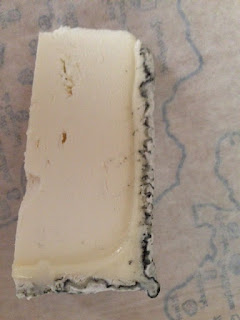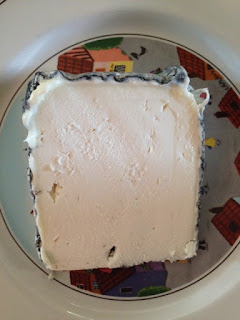When I was in France on a three-week whirlwind trip in the 90s, one of my favorite things to do after seeing the sights in Paris was to go to the fromagerie located near the hotel where I was staying. There, I found some of the most incredible cheeses imaginable. I fell in love with both the Petit Munster and the Petit Pont L'Eveque. Both of these cheeses are of the wash-rind variety, and the flavor of each is bold, funky and not for the meek. I smuggled some into the United States on my way home. Since the gentleman in customs acknowledged both the cheese and the beautiful Poilane boule I was carrying and let me go with nothing more than a joke about people not being fed this kind of food in the United States, getting the goodies into this country was not as dangerous as it sounds, though it probably wouldn't be so easy now. Whenever I asked about Petit Munster here in the United States, I was directed to sliced muenster cheese, a different animal altogether. Petit Munster is a semi-soft, wash-rind cheese that has a strong aroma and a slightly sticky outer surface.
After many years of searching for the Petit Munster here, I found some at a local supermarket. It's not cheap, but I decided to splurge and try it. It was very good, but this was nothing like what I had in France, not even close. All of a sudden, I was on a mad quest. There had to be a way to find this cheese, the one I remembered so well.
 |
| This pale-looking Petite Munster cheese has a mild flavor. |
I scoured online cheese websites, made calls, sent emails, and asked local cheese mongers where I could find this cheese, all to no avail. The only one out there seemed to be the one produced by Haxaire. That was the same one I found at the supermarket. Finally, I found a description on Igormet that seemed different. Could it be? It sounded like it was the very cheese I wanted, but I had to make sure. In a chat with an Igormet representative, I explained that I had purchased the Haxaire producer's version, which was nice but not what I consider true Petit Munster, and I was hoping to find and purchase the Jean Roussey version or something similar. The lady offered me a more detailed description, and it sounded exactly like what I wanted. I ordered some despite it being an even larger splurge.
The days seemed to take weeks to pass as I waited impatiently for my cheese to arrive, but eventually, it showed up at my doorstep. When I tore into the package, I was not happy to find the exact same Haxaire produced Petit Munster I had purchased (for half the price!) earlier. Fortunately, after I explained the situation to the Igourmet representative, I was refunded, but the whole experience left me disappointed. The search continues, only less enthusiastically now that I know it's unlikely I will ever find what I'm looking for. I haven't given up completely, though. Also, it was nice of Igourmet to let me keep what they had sent, even though it wasn't what I wanted.
 |
| A darker Petite Munster tasted about the same as the lighter one. |
Below is my review of the Haxaire Petite Munster.
I could very simply state that this cheese tastes like Camembert, but I think my readers want more information than that. It's similar to Camembert, but it's not exactly the same, of course. Despite receiving two cheeses with the same label, you will notice that the second cheese is distinctly more orange in color. One might guess that the first is a younger cheese, but it's more likely that the rind on the second developed more bacteria during the aging process. Still, the flavor of both was almost identical, though the smell of the second was a wee bit funkier, and the rind was also stickier.
Traditional Petit Munster is made with a high-protein, unpasteurized milk from the Vosges, an area near Alsace, and it's aged, often in caves or cellars owned by monasteries and abbeys, in the town of Munster. The cheese is protected by an Appellation d'Origine Controlee that ensures producers rigorously observe various steps in the cheesemaking process. Inside the wash rind that tastes more like a bloomy rind than the familiar pungent ones associated with most cheeses in this genre is a beautiful ivory paste. The texture is fat and beefy. The first cheese I bought was like ambrosia, delicate with a light, flavorful taste. The second was just a little bit more pungent, and the texture was heavier. Both are mild with notes of button mushrooms, milk and butter and a faint taste of Brazil nut. As the cheese ages, its flavor becomes more pronounced.
Petit Munster can be served hot or at room temperature. Bake it and serve it with crusty bread, slice it onto salads, serve it with fresh fruit, try it with boiled potatoes and sesame and cumin seeds, or place a wedge on a cracker or apple slice topped with honey. This cheese with pairs well with Gewurztraminer, Pinot Blanc, Chardonnay, Riesling, Pinot Noir, Sangiovese, Sauternes or Jurancon.
 |
| Pair Petite Munster with Gewurztraminer. |







































